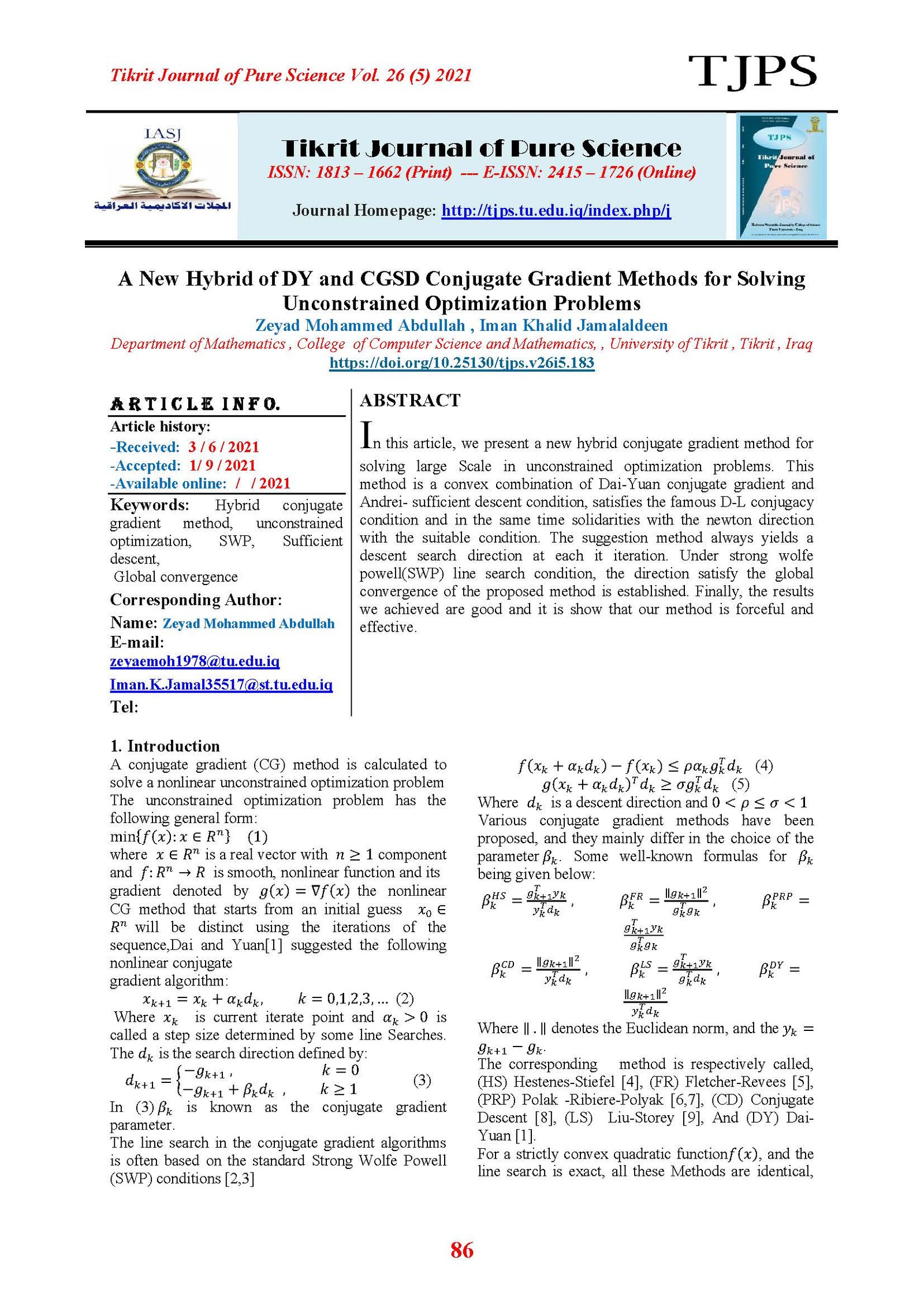A New Hybrid of DY and CGSD Conjugate Gradient Methods for Solving Unconstrained Optimization Problems
Main Article Content
Abstract
In this article, we present a new hybrid conjugate gradient method for solving large Scale in unconstrained optimization problems. This method is a convex combination of Dai-Yuan conjugate gradient and Andrei- sufficient descent condition, satisfies the famous D-L conjugacy condition and in the same time solidarities with the newton direction with the suitable condition. The suggestion method always yields a descent search direction at each it iteration. Under strong wolfe powell(SWP) line search condition, the direction satisfy the global convergence of the proposed method is established. Finally, the results we achieved are good and it is show that our method is forceful and effective.
Article Details

This work is licensed under a Creative Commons Attribution 4.0 International License.
Tikrit Journal of Pure Science is licensed under the Creative Commons Attribution 4.0 International License, which allows users to copy, create extracts, abstracts, and new works from the article, alter and revise the article, and make commercial use of the article (including reuse and/or resale of the article by commercial entities), provided the user gives appropriate credit (with a link to the formal publication through the relevant DOI), provides a link to the license, indicates if changes were made, and the licensor is not represented as endorsing the use made of the work. The authors hold the copyright for their published work on the Tikrit J. Pure Sci. website, while Tikrit J. Pure Sci. is responsible for appreciate citation of their work, which is released under CC-BY-4.0, enabling the unrestricted use, distribution, and reproduction of an article in any medium, provided that the original work is properly cited.
References
[1] Dai, Y. H., & Yuan, Y. (1999). A nonlinear conjugate gradient method with a strong global convergence property. SIAM Journal on optimization, 10(1), 177-182.
[2] Wolfe, P. (1969). Convergence conditions for ascent methods. SIAM review, 11(2), 226- 235.
[3] Wolfe, P. (1971). Convergence conditions for ascent methods. II: Some corrections. SIAM review, 13(2), 185-188. [4] Hestenes, M. R., & Stiefel, E. (1952). Methods of conjugate gradients for solving linear systems. Journal of research of the National Bureau of Standards, 49(6), 409-436. [5] Fletcher, R., & Reeves, C. M. (1964). Function minimization by conjugate gradients. The computer journal, 7(2), 149-154. [6] Polak, E., & Ribiere, G. (1969). Note sur la convergence de méthodes de directions conjuguées. ESAIM: Mathematical Modelling and Numerical Analysis-Modélisation Mathématique et Analyse Numérique, 3(R1), 35-43.
[7] Polyak, B. T. (1969). The conjugate gradient method in extremal problems. USSR Computational Mathematics and Mathematical Physics, 9(4), 94-112.
[8] Fletcher, R. (1987). Practical methods of optimization john wiley & sons. New York, 80, 4.
[9] Liu, Y., & Storey, C. (1991). Efficient generalized conjugate gradient algorithms, part 1: theory. Journal of optimization theory and applications, 69(1), 129-137.
[10] Jardow, F. N., & Al-Naemi, G. M. (2020). A new hybrid conjugate gradient algorithm for unconstrained optimization with inexact line search. Indonesian Journal of Electrical Engineering and Computer Science, 20(2), 939-947.
[11] Dai, Y. H., & Yuan, Y. (2001). An efficient hybrid conjugate gradient method for unconstrained optimization. Annals of Operations Research, 103(1), 33-47.
[12] Dai, Y., & Yuan, Y. (2003). A class of globally convergent conjugate gradient methods. Science in China Series A: Mathematics, 46(2), 251-261.
[13] Andrei, N. (2008). A Dai–Yuan conjugate gradient algorithm with sufficient descent and conjugacy conditions for unconstrained optimization. Applied Mathematics Letters, 21(2), 165-171.
[14] Jardow, F. N., & Al-Naemi, G. M. (2020). A new hybrid conjugate gradient algorithm for unconstrained optimization with inexact line search. Indonesian Journal of Electrical Engineering and Computer Science, 20(2), 939-947.
[15] Dai, Y. H., & Liao, L. Z. (2001). New conjugacy conditions and related nonlinear conjugate gradient methods. Applied Mathematics and Optimization, 43(1), 87-101.
[16] I. Bongartz, A.R. Conn, N.I.M. Gould, P.L. Toint, CUTE: Constrained and unconstrained testing environments, ACM Trans. Math. Software 21 (1995) 123–160.
[17] N. Andrei, Test functions for unconstrained optimization.
